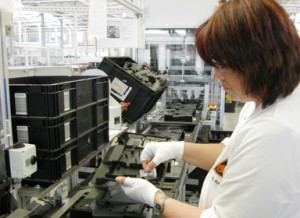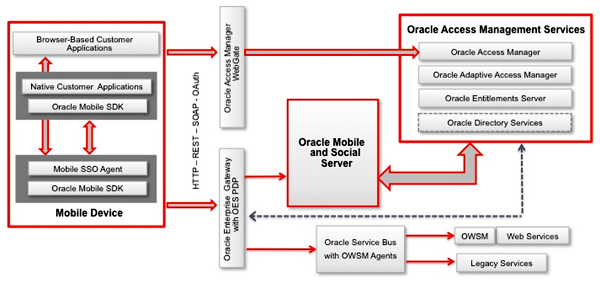A discussion on why RFID is now ready for comprehensive and integrated use in the production and distribution in secure product identification, logistics and tracking
by Markus Weinländer, Siemens Industry Automation
Radio frequency identification (RFID) has for many years been considered an important aid for controlling a production capable of many variants – for applications in delivery logistics, however, the technology has not been able to push through so far. But thanks to the implementation of the EPCglobal standard in industrially suited systems, RFID is now ready for integration.
This vision, a basis for innovative logistics concepts all the way to the “Internet of Things”, is gradually becoming a reality with the introduction of the EPCglobal standard and the use of low-cost RFID labels – which can also be read when obscured, in bulk and from a distance of several meters. For the first time, RFID can be utilized to record entire shipments on pallets at the entrance gate without the lengthy ‘shooting’ of barcodes – at transponder prices far below the cost of previously available systems with comparable range. The marking of individual deliveries, packaging units or even individual articles with RFID labels can be implemented step by step. The basis for this is the use of the UHF band (ultra-high frequency) around 865 MHz.
In the industry, though, the EPCglobal technology could not readily be employed for applications in manufacturing, material flow control and supplier logistics. This is due to the different requirements: A carmaker, for example, depends on a 100% hit rate – a capture rate of 99% (which may appear acceptable in logistics applications) would mean several hundred errors daily for a large plant. At the same time, overshoots must be avoided at all costs, since a misreading may not only cause a misentry during receiving, but – in the worst case – damage machines, should a robot run through the wrong motion curve.
Powerful algorithms
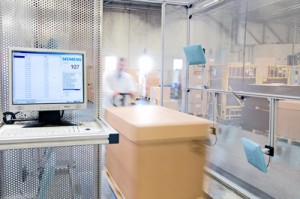 Technology providers, such as Siemens, have stepped up a gear to meet the requirements. The UHF RFID technology of Siemens’ product family SIMATIC RF600 has been readied for use in the production and industrial logistics. Among these are powerful algorithms in the readers, various antenna types for different applications and a wide variety of transponders and so-called smart labels – low-cost self-adhesive labels with radio chips. The firmware in the reading devices, for example, now enables the adaptive adjustment of the transmission power to the present needs. Overshoots can be filtered out in several ways, which – among others – employ statistical methods. It can thereby be ensured that – despite overshoots – only the transponder actually intended to be processed is reported to the higher-level system.
Technology providers, such as Siemens, have stepped up a gear to meet the requirements. The UHF RFID technology of Siemens’ product family SIMATIC RF600 has been readied for use in the production and industrial logistics. Among these are powerful algorithms in the readers, various antenna types for different applications and a wide variety of transponders and so-called smart labels – low-cost self-adhesive labels with radio chips. The firmware in the reading devices, for example, now enables the adaptive adjustment of the transmission power to the present needs. Overshoots can be filtered out in several ways, which – among others – employ statistical methods. It can thereby be ensured that – despite overshoots – only the transponder actually intended to be processed is reported to the higher-level system.
For the setup of reading points, RF-DIAG, provides practical support for the initial setup, optimization and error diagnostics. It does so, for example, via a live-display of all acquired transponders including the necessary quality parameters, and through a direct parameterization of the readers from the tool. Replacing devices is now also very easy, since all parameters are automatically transferred from the controller SIMATIC S7 (PLC, programmable logic controller) to the readers using various connections such as PROFIBUS or PROFINET. Finally, quality data can be retrieved by the PLC – and be prepared for the visualization on a SIMATIC HMI panel – to evaluate the reading point (for preventive maintenance or diagnostics while in operation).
Permanently mark
The UHF RFID technology has many important advantages for users. For the first time, it is possible to permanently mark products or auxiliary items (pallets, transport containers, tools) with RFID using low-cost smart labels that nevertheless provide a long range. In the production, for instance, where circulating data media had previously been used almost exclusively, complex data storage and data transfer measures were needed when the transponder was removed from the product or the product was separated from its transport unit (e.g., skid). It had to be ensured that the data remained available for each individual product. Especially in the case of manual intervention, this could lead to errors that required great effort to be corrected. By means of UHF RFID, all data is now kept directly at the product – virtually ruling out a loss of data.
In industrial logistics, on the other hand, an economical tracking of the transport containers or tools had been nearly impossible so far. As a consequence, for example, an inventory optimization with regard to the turnover rate could hardly be performed – simply because the necessary database was missing. Without complete information, the control of secondary processes as well, e.g., for the maintenance and cleaning of the transport units, could only take place “on suspicion”, i.e., by means of set intervals. However, if a complete usage history (“container passport”) is automatically generated, these auxiliary steps can occur according to actual use.
Especially useful is the combination of different processes. Since the objects are now permanently marked, a transponder can be utilized for a variety of purposes. For instance, the logistics between supplier and product manufacturer can be monitored, the production be controlled, the stock-keeping be optimized and the outgoing goods posting be automated. The worldwide standard EPCglobal and its industrial-grade implementation in suitable reading devices, antennas and transponders make it possible to utilize a common infrastructure for numerous moving goods. In many applications, the return on investment can thus be proven quite well and achieved in a reasonably short time.
Strategic UHF RFID
UHF RFID, though, can be more than just an optimizer – in some companies, it becomes the tool for the implementation of the corporate strategy. The use of RFID enables new business models, which before could not or only with difficulty be realized. If a company wants to set itself apart from the competition, e.g., by offering a particularly wide range of products, a sophisticated production and logistics concept has to ensure that the costs do not rise excessively. When converting to a production capable of many variants (mass customization), the company no longer produces in advance, but order-related. The stock-keeping and logistics as well have to adjusted to a manufacturer that no longer supplies goods in bulk to its sales partners, but individual items to end customers.
Another strategic objective can be the improvement of the cost position. Through RFID, it is possible to optimize the inventory and to lower the capital commitment for auxiliary items such as transport containers. This allows, e.g., the logistics to operate more cost-effectively. If a continuous monitoring is achieved through UHF RFID, the delivery reliability can be improved for the same unit cost, e.g., incorrect deliveries can be eliminated. Only such measures make it even possible to promise certain performance characteristics such as a 100% error-free delivery.
Last but not least, the use of RFID can raise the market entry barrier for competitors, particularly in production networks. If UHF transponders are consistently employed in a supply relationship (e.g., between supplier and manufacturer), the degree of integration between both companies increases. It therefore becomes more difficult for competitors to displace the current supplier – it no longer suffices to “just” offer better products, the process quality with the necessary technical infrastructure also has to be equaled or exceeded. Especially for medium-sized companies, this represents an opportunity for gaining a significant competitive advantage.
Automotive
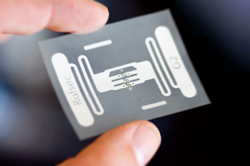 Major suppliers to the automotive industry already employ UHF RFID in the production. As one of the first companies, Rehau has optimized the production of bumpers using SIMATIC UHF components. After the injection molding, a smart label is glued to the bumper, which then follows all production steps (e.g., employees are shown installation instructions for each bumper, adjustment settings of machines) all the way to the correct loading into trucks for just-in-time/just-in-sequence logistics. ZF Getriebe equips its transmission housings with a UHF transponder, which in addition to radio technology also utilizes an engraved 2D data matrix code and plain text number. When employing RFID, the user data can be reprogrammed during the production process – so that the cycle times can be reduced through decentralized data storage.
Major suppliers to the automotive industry already employ UHF RFID in the production. As one of the first companies, Rehau has optimized the production of bumpers using SIMATIC UHF components. After the injection molding, a smart label is glued to the bumper, which then follows all production steps (e.g., employees are shown installation instructions for each bumper, adjustment settings of machines) all the way to the correct loading into trucks for just-in-time/just-in-sequence logistics. ZF Getriebe equips its transmission housings with a UHF transponder, which in addition to radio technology also utilizes an engraved 2D data matrix code and plain text number. When employing RFID, the user data can be reprogrammed during the production process – so that the cycle times can be reduced through decentralized data storage.
Interesting applications can also be found outside of the automotive industry. The aluminum producer Aleris studied the use of RFID for the management of its transport containers, and as a result equipped the up 130 °C hot steel crucibles with transponders. Capturing the containers are permanently installed reading points, which at the plant exit perform their duties even outdoors – without complaint. Besides automatically tracking the exact delivery route (e.g., proof of transfer of risk), the usage history of the containers aids in optimizing secondary processes such as the container cleaning.
Siemens itself also relies on UHF RFID technology. At its telephone plant in Leipzig (Germany), a radio chip is inserted into each IP telephone, which is utilized for both the production control and logistics. Thanks to the bulk capture of more than 100 telephones at once, the shipping center in Eltersdorf (Germany) can now automatically list the serial numbers of the devices supplied on every delivery note and also notify the relevant systems – e.g., important data for warranty processing.
Industrial applications
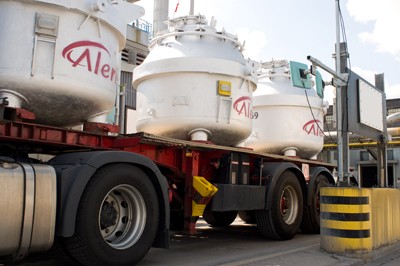 The use of UHF RFID in industrial applications is far from being exhausted. There is still much to be explored with regard to the consistent use of RFID labels across plant and company boundaries. The numerous, different barcodes (manufacturer code, logistics data, additional parts information, etc.) on a standard shipment by freight carrier between companies alone point out where improvements are possible and necessary.
The use of UHF RFID in industrial applications is far from being exhausted. There is still much to be explored with regard to the consistent use of RFID labels across plant and company boundaries. The numerous, different barcodes (manufacturer code, logistics data, additional parts information, etc.) on a standard shipment by freight carrier between companies alone point out where improvements are possible and necessary.
In an unprecedented project, this is currently being studied for the automotive industry. The project RAN (RFID-based automotive network) – funded by the German Federal Ministry of Economics and Technology – is, for the first time, examining the integrated identification via RFID in the automotive supply chain. Using various scenarios, it analyzes how UHF can be beneficial to the participating partners – with promising results.

